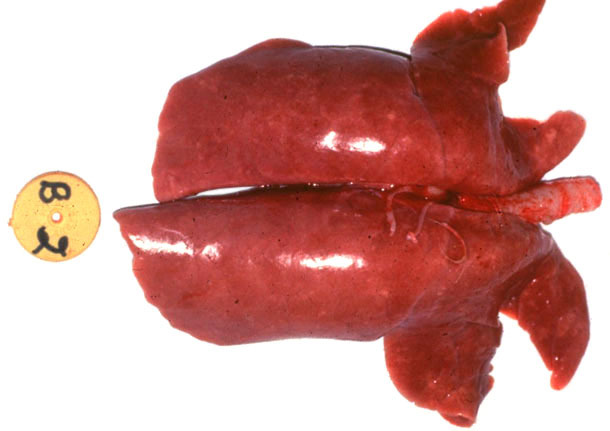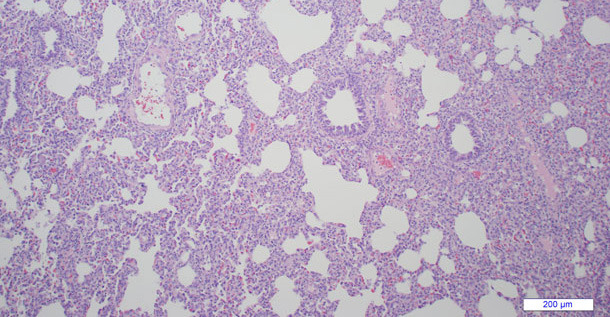Clinical signs of PRRS
PRRS virus (PRRSV) establishes systemic infection in infected pigs resulting in similar clinical presentation in pigs of all ages although outcome of infection can be age-dependent. Clinical signs, when apparent, vary and are influenced by:

- Virulence of the virus
- Pre-existing immunity from previous infection or vaccination
- The presence of other pathogen(s) in the population
- Herd size and management practices.
At the same time subclinical infection (e.g., chronic carrier) is not uncommon.
Clinical signs that are most commonly observed with PRRSV infection regardless of age include anorexia, fever, lethargy, depression and respiratory distress. Vomiting and mild cyanosis of the ears, abdomen and vulva have been reported in some outbreaks. Severe and diffused cyanosis can be observed in some cases (e.g., “high-fever” PRRS). In breeding herds, a decrease in the number of dams that conceive or farrow is the most obvious sign of PRRS. An increase in premature farrowing, late term abortions and stillborn or weak piglets have commonly observed with PRRS oubtreaks. An increase in mummified fetuses has also been reported. The preweaning mortality rate goes up significantly in affected herds. Weaning pigs may show “thumping” (i.e, dyspnea). Sudden diarrhea in neonatal pigs can be a clinical sign requiring attention in PRRS naïve herds if any known enteric disease pathogens are not implicated. The period for reproductive problem varies with herd size but is usually 2 to 3 months in duration which is followed by a slow improvement in reproductive performance. In larger operations, disease signs may be cyclic, especially if naïve gilts or sows continue to be introduced into the herd which can generate subpopulations with varying immunity. It is also possible that herd may be exposed concurrently or repeatedly to multiple heterologous strains of PRRSV which cannot be completely cross-protective, leading to cyclic infection and outbreaks. Affected boars can show loss of libido and a decrease in semen quality besides clinical signs similar to ones in affected sows. In young and growing pigs, primary clinical manifestations are pneumonia and growth retardation. Clinically, a period of sneezing, fever and lethargy is followed by expiratory dyspnea (i.e., “thumping”) and stunting. Postweaning mortality is often markedly increased in the affected herds. PRRSV-associated respiratory disease is most prevalent in pigs at age of 4 to 10 weeks; yet, infections with heterologous strains can also lead to prolonged or repeated outbreaks of respiratory diseases in grow/finisher herds. An increased rate of secondary infections has been a frequent complaint in herds affected by PRRS.
Laboratory diagnosis of PRRS
Clinical signs (See above) with supportive gross lesions and history often suggest PRRS, especially in acute outbreaks. Characteristic microscopic lesions in lungs and several other tissues (figure 2) are also suggestive of PRRSV infection but not pathognomonic. Any tentative clinical diagnosis then should be confirmed by detection of PRRSV (i.e., infectious virus, viral antigens and/or viral genomic material) in affected pigs using laboratory methods in conjunction with typical lesions. Immunohistochemistry is commonly used on formalin-fixed tissues to demonstrate the presence of viral antigen within lesions although PCR has been a main laboratory method to demonstrate the presence of PRRSV in a variety of clinical specimens. Serology provides indirect evidence of PRRSV infection or exposure but does not determine if there is actual disease caused by the virus. Paired serum sampling with 2- to 3-week interval can be useful to determine if PRRSV infection was implicated in clinical problem. A series of blood samples from various stages of production may be useful to determine the age of pigs most commonly infected with PRRSV within a herd.

Figure 1. Gross appearance of lung severely affected by PRRSV. The lung is swollen, mottled and tan color.
(Photo Courtesy: Dr. Greg Stevenson at Iowa State University)
The interstitial pneumonic lesion is a most common finding in respiratory disease by PRRSV infection but varies from multifocal to lobular to diffuse in distribution. Grossly, lungs from affected pigs appear mottled and tan but are highly variable in extent (Figure 1). Lymph nodes are generally swollen, tan and edematous or cystic. Microscopically, nonsuppurative interstitial pneumonia is a prominent lesion (Figure 2). In addition, mild nonsuppurative encephalitis, myocarditis and/or rhinitis can be observed in affected pigs. Endometritis, myometritis and placental lesions have been reported in sows with acute PRRSV infection. Most aborted fetuses and stillborn pigs with uncomplicated PRRS generally have no discernable lesions. If present, the following lesions have been reported:
- Umbilical cord arteritis and hemorrhage
- Patchy distribution of slightly firm lungs (interstitial pneumonia)
- Enlargement of lymph nodes
- Hemorrhages in the skin
- Edema of the eyelids, periorbital tissue, colonic mesentery and various body cavities
- Dehydration with prominence of the vertebral column

Figure 2. Microphotography of interstitial pneumonia in lung affected by PRRSV. Alveolar septa are thickened and interstitial space is filled with various inflammatory cells. (Photo Courtesy: Dr. Greg Stevenson at Iowa State University)
Detection of PRRSV is best performed in affected pigs during the early stage (i.e., acute) of PRRSV infection. Suitable specimens are obtained from weakborn neonates that have not nursed, clinically affected (thumping, febrile) nursing pigs, and/or from febrile, anorectic weaned pigs and adult pigs (e.g., sows). The best clinical specimens for virus detection in individual pigs include serum, lung, bronchoalveolar lavage (BAL) fluid, lymph nodes, tonsil and spleen. Oral fluid is an excellent sample for determining the presence of virus in a population (i.e., surveillance). In case of reproductive problem, aborted or stillborn piglets can be used for the diagnosis of PRRSV infection by performing a polymerase chain reaction (PCR)-based test on bodily fluids or thymus but are frequently negative due to sampling time (i.e., stage of infection) or sample quality (e.g., autolysis). The accuracy of diagnosis can be enhanced by including samples from sows in testing. Sows that are acutely ill at the time of abortion should have virus in serum that can be detected by laboratory tests. Sows that are not sick at the time of abortion are usually not viremic but should have high antibody levels in serum.
Differential diagnosis for respiratory disease includes influenza A virus, porcine circovirus type 2, porcine respiratory coronavirus, pseudorabies virus, Mycoplasma hyopneumoniae, Actinobacillus pleuropneumoniae, Streptococcus suis, Salmonella choleraesuis, Haemophilus parasuis, and Pasturella multocida. For reproductive failure, differential diagnosis includes porcine parvovirus, influenza A virus, porcine teschovirus/enterovirus, pseudorabies virus, classical swine fever virus, porcine cytomegalovirus and leptospirosis.







